If you want tender, light, and fluffy basmati rice in a hands-free, no-fuss method then try out making it with a rice cooker. This recipe will teach you how to make both white and brown basmati rice with perfect results using a rice cooker.
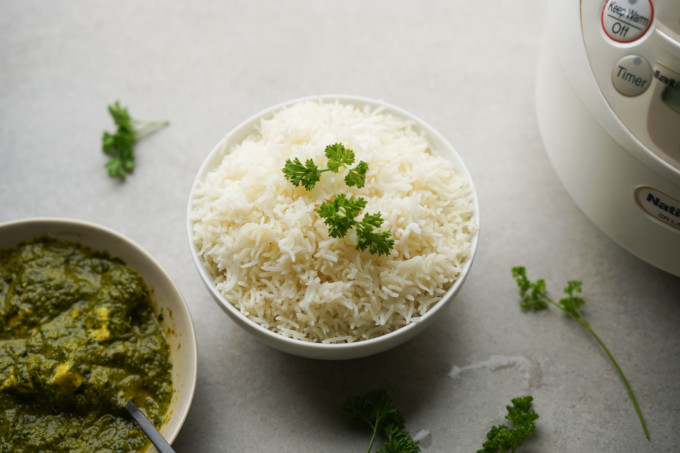
Can you cook basmati rice in a rice cooker?
Cooking basmati rice in a rice cooker is a game-changer if you want a hands-free, no-fuss method to make rice during the week. Making basmati rice is a must when you’re serving it alongside a dish like butter chicken recipe (Indian murgh makhani). Just like the Instant Pot basmati rice recipe, this basmati rice cooker recipe is simple to follow these easy instructions below based on the specific type of basmati rice you want to cook.
White vs brown basmati rice
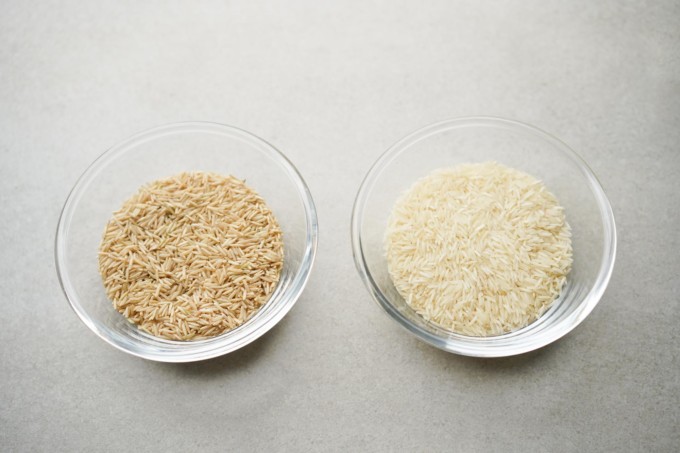
Like other varieties of rice (for example jasmine or short-grain rice), Indian basmati rice comes in white and brown versions and you can definitely cook both in a rice cooker. For this recipe, we used India Gate aged white basmati rice and Royal premium-aged brown basmati rice. The main difference between white and brown basmati rice is that the latter still has its outer bran layer intact.
Basmati rice to water ratio
Use the following ratio below to get the adequate proportions and servings you need for your next recipe:
White basmati rice
- 2 servings: 1 cup (200 g) white basmati rice for 1 ½ cups (10 fluid ounces) water
- 4 servings: 2 cups (400 g) white basmati rice for 3 cups (20 fluid ounces) water
Brown basmati rice
- 2 servings: 1 cup (200 g) white basmati rice for 2 cups (16 fluid ounces) water
- 4 servings: 2 cups (400 g) white basmati rice for 4 cups (32 fluid ounces) water
Brown basmati rice usually has a nuttier flavor than its white counterpart and can also take additional time to soak or cook whether that’s in a rice cooker or on the stove. Regardless, both brown and white basmati rice use different rice to water ratios when using a rice cooker.
How do you cook basmati rice in a rice cooker?
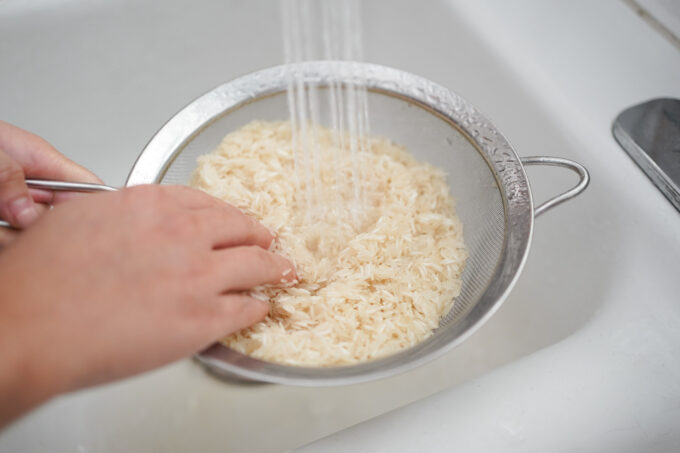
When cooking any type of rice, it’s best to first clean the rice with water to remove the excess debris and excess starch. Use a strainer under running water in the sink for a fast and easy way to rinse the rice.
For the brown basmati rice, I like to soak the rice in water for at least 30 minutes to allow the rice to hydrate before cooking. Many brown rice varieties can be fairly al dente or hard once cooked and this pre-soaking gives you more moist and plump grains of rice.
After transferring the rice to the rice cooker pot, mix in some melted ghee or extra virgin olive oil in the rice cooker. Adding in a fatty ingredient helps to give the rice flavor, but also keeps them from sticking together once it’s cooked. There’s also an option of adding a pinch of kosher salt for even more flavor.
Once all the rice is mixed with ghee (or oil) and salt, add the water on top and level out the top of the grains so that it’s flattened. With my rice cooker, I typically stick with the normal “rice” setting and this always gives me plump grains. Make sure to read your rice cooker’s instructions for best results.
Once the timer finishes, don’t open the lid just yet! Leave the rice with the lid on for an additional 10 minutes with the warming function on. Leaving the rice to rest helps soak up any extra moisture and keeps your grains whole (aka prevents them from splitting while cooking).
Tips
Here are some tips to troubleshoot any issues with your rice:
- If your rice is too hard, you need to add more water. To fix your current rice, add about two tablespoons of rice and microwave it in a bowl with a towel covering the bowl for about 30 seconds. Add more water and continue to microwave if it’s still too hard. In the future, add two tablespoons (or more depending on the hardness) from the beginning.
- If your rice is too wet, you need to reduce the amount of water by ¼ of a cup the next time you make a new batch. Unfortunately, there’s no way to remove liquid after you’ve cooked it, so it’s best to either eat it as is or turn it into something else like cháo gà (Vietnamese chicken rice porridge / congee).
Does basmati rice require more water?

Yes, this basmati rice recipe does require more water to cook compared to other types of rice like jasmine rice or short-grain rice. Especially for brown basmati rice, you will need to pre-soak the rice before cooking to get plump grains. When we didn’t soak our brown rice before cooking, we found it to be less tender.
To learn how to make other types of rice, learn here:
- jasmine rice in an Instant Pot
- white rice in a rice cooker
- brown rice in a rice cooker
- white rice in a microwave
- brown rice in a microwave
- white rice in an Instant Pot
- brown rice in an Instant Pot
- how to cook sticky rice
- how to make sushi rice
- Instant Pot basmati rice
- Aroma Rice Cooker Instructions
- easy, buttery seasoned rice

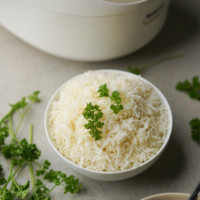
White Basmati Rice Recipe
Ingredients
- 200 g (1 c) white basmati rice
- 12 fl oz (1 ½ c) water plus more for rinsing
- ½ fl oz (1 tbsp) melted ghee or extra virgin olive oil
- 3 g (½ tsp) kosher salt
Equipment Used
- Strainer
- kitchen scale or dry and wet measuring cups
- rice paddle
Instructions
- Measure out all the ingredients.
- Pour the rice into a strainer and rinse under running water until the water runs clear.
- Transfer the rice into the rice cooker and mix in the melted ghee (or extra virgin olive oil). Use a spoon or spatula to coat every grain.
- Sprinkle with salt and mix again.
- Pour the water over the rice and flatten out the top of the rice so the rice lays flat.
- Follow the instructions for your rice cooker. My rice cooker has a basic “rice” setting that I press and press the “start” button.
- After the rice has finished cooking, leave it to rest for 10 minutes without opening the lid.
- After 10 minutes, open the lid and fluff with a rice paddle.
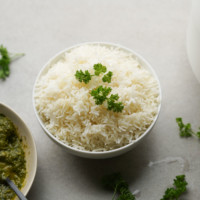
Brown Basmati Rice Recipe
Ingredients
- 200 g (1 c) brown basmati rice
- 16 fl oz (2 c) water plus more for rinsing
- ½ fl oz (1 tbsp) melted ghee or extra virgin olive oil
- 3 g (½ tsp) kosher salt
Equipment Used
- Strainer
- kitchen scale or dry and wet measuring cups
- rice paddle
Instructions
- Measure out all the ingredients using a kitchen scale or dry and wet measuring cups.
- Place the rice into a strainer and clean it under running water until the water runs clear.
- Transfer the brown basmati rice to the rice cooker and add enough water so that it covers at least one inch above the top of the rice.
- After soaking for 30 minutes, drain the excess water.
- Pour the melted ghee (or extra virgin olive oil). Mix until the grains are covered. Sprinkle the salt and mix again.
- Pour the water into the rice cooker and then mix again.
- Flatten out the top of the rice until it’s leveled.
- Close the lid and follow your rice cooker’s instructions for rice. For my rice cooker, I use the normal “rice” setting and press start.
- After the rice is finished cooking, allow the rice to rest in the rice cooker with the lid on for an additional 10 minutes.
- After 10 minutes of resting, open the lid and fluff the rice with a rice paddle. Serve immediately.



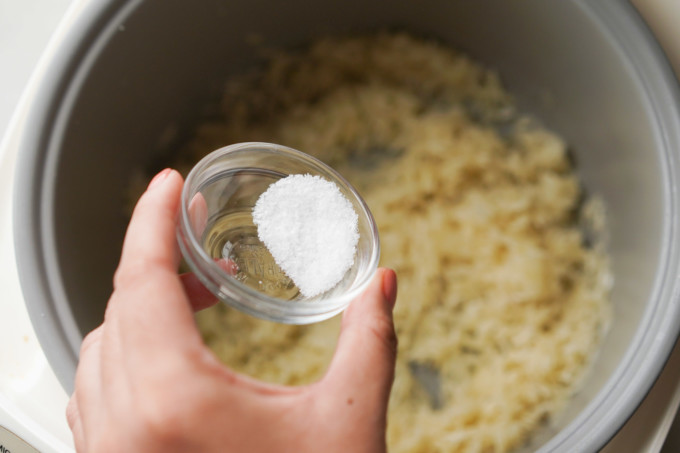
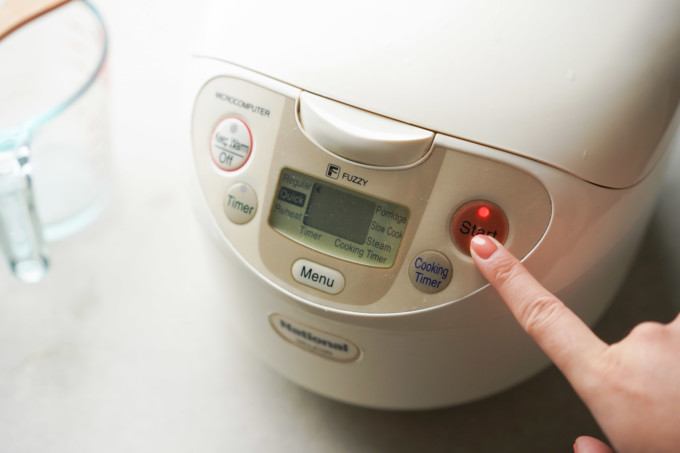
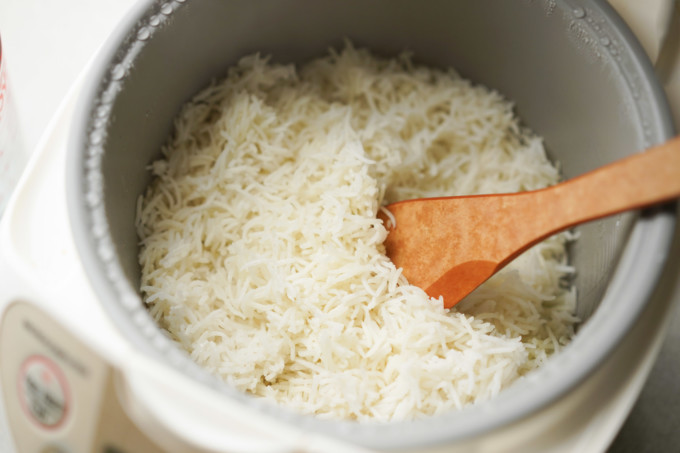
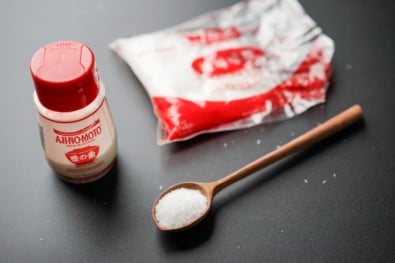



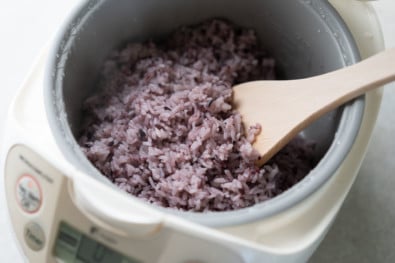




This recipe/instructions was amazing! Rice was a good texture and very similar to the texture I’ve had in restaurants.
Thanks LadyDi!
Thank you sooooo much! The Zojirushi is an amazing rice cooker but I was having issues with brown basmati. Your method is fantastic!
Great to hear Ana, thanks!